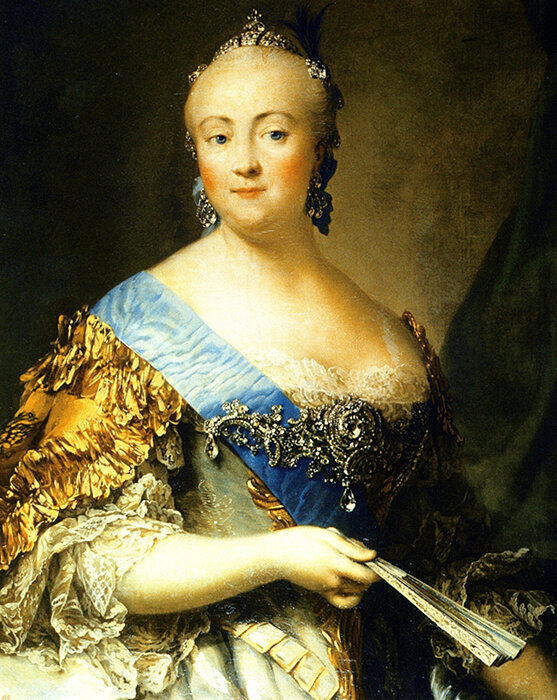The Roman Dynasty ruled Russia from 1613 to 1917. Here, author Ellen Alpsten tells us of the tough life that women led during the period – and considers how one of the heroines in her book came to be such a powerful figure in a male-dominated country.
A 1750s portrait of Elizabeth Petrovna, Empress of All Russia from 1741 to 1762.
Both researching the wild, pitiless world of the Russian Baroque – think late 17th and early to mid-18th century – and writing The Tsarina’s Daughter made me discover many fascinating if fearsome facts. Next to the incredible ingenuity applied to make people suffer in torture and execution for the slightest offence to any authority, be it the Russian Orthodox Church or the Tsar, I was shocked to learn about the rampant maltreatment of women.
God’s Beast of Burden
My research made me reflect about my gender and the lives we led throughout history. Women were God’s beast of burden: multitasking and toiling from dawn to dusk. If people and historians go misty-eyed when speaking of the 'good old days', thinking of a closer social cohesion and man's limited spiritual horizons, which made for a simpler life, these were terrible days for the ‘weaker sex’. ‘Her-story’ is not only written by Queens and Princesses, but any woman, of which social standing whatsoever, everywhere. Girls received no education other than household chores. Early marriage - sometimes as early as the age of 12 – happened to an often much elder man, who suited your parents, cementing their status and relationships in the village. This husband probably soon turned violent with drink: the liquor of the serfs, the million-fold ground cover of the Russian Earth is called kvass, a bitter drink made of fermented bread. Only steady stupor allowed the poor to suffer their fate. For any woman, annual childbirth was a gamble of life and death. Also, in Russia, the harsh climate and the lack of healthcare forced a mother to see at least half of her offspring die. There was no privacy and certainly not the modern luxury of me-time, or neither dreams nor hopes - just toiling, toiling, toiling from dawn till dusk.
War as a harbinger of progress
If life was marginally better for women of high standing, the Petrine laws of inheritance introduced by Peter the Great changed the situation substantially for all women. War brought unimaginable suffering to women – losing their sons and husbands – but it was also a harbinger of progress and modernity. In the case of my research for the Tsarina series, I learnt about the most important conflict European history ever forgot: The Great Northern War, Russia’s battle for survival against the then supreme power-player Sweden. No price was too high to pay for Russia’s survival. In Peter the Great’s realm nothing was as superfluous and expendable as human life. His legislative system responded to the challenge the war against Sweden raised: If all men stand in battle, the women have to be allowed to work, running trade. If all sons stay in the field, an unmarried eldest daughter must be allowed to inherit, whilst a second daughter might be widowed and is provided for by property.
A milestone for Emancipation
The Italian newspaper La Stampa in its glorious review of The Tsarina's Daughter pointed out the changing female situation as a strong point of the novel: ‘Her voice overcomes a fate raging against her.’
If the women in The Tsarina’s Daughter have mostly no choice then to succumb to male dominance, my heroine Elizabeth makes an exception to that rule. If her path proved to be stony and often marked by life-threatening situations, her decisions remind us of the freedom that modern women have today. In her life, we witness a milestone in female emancipation and empowerment. Like an inverse Cinderella story, she bears testimony of the strength of human nature and the absolute will to survive. She also transgressed other borders – when threatened with being banished to a convent for her many affairs and the freedom with which she lived her passions, the Spanish envoy noted, deeply scandalized, that ‘she has not an ounce of nun’s flesh on her body and all her faults are in character and not in her appearance.’
A Popular People’s Princess
How then could a woman such as my heroine Elizabeth Petrovna, the great Tsar’s daughter and the only surviving of her fifteen siblings, overcome the deeply enrooted obstacles of a male dominated system? Peter the Great’s death left a vacuum of power, which allowed for one of the most complex situations in Russian history. Such as Goethe’s The Sorcerer’s Apprentice, the country could not master the spirits that it roused: the huge influx of westerners generated by the great Tsar and his successors. As the realm struggled for survival, Elizabeth cleverly played the popular card. The Russians are a communal people – the word for happiness -‘shast’ye’- means being part of something bigger. The Tsarina’s Daughter was one of them, sharing the complexities and stark opposites of the Slavic soul: born to countless palaces, she preferred camping in the Russian countryside. If JS Bach was invited to become the Romanov’s composer of choice, she sung crude peasant songs and danced with her subjects through many a White Night. While she at her death owned 15,000 gemstone-encrusted gowns, she preferred dressing in often traditional male dress, allowing for an unencumbered lifestyle. She allowed unwittingly for an image of a Russian woman that was further institutionalized by the Soviets, equalizing the female situation in Russia – at least nominally so.
The Tsarina’s Daughter by Ellen Alpsten (Amazon), published by Bloomsbury, is out in hardback on July 8, and Tsarina, Ellen’s first book, is out in paperback now (Amazon US | Amazon UK).







